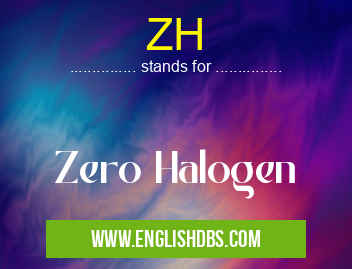What does ZH mean in UNCLASSIFIED
In the realm of electronics and manufacturing, the term ZH stands for Zero Halogen. It refers to materials or products that are free from halogen elements, primarily chlorine, bromine, fluorine, and iodine.

ZH meaning in Unclassified in Miscellaneous
ZH mostly used in an acronym Unclassified in Category Miscellaneous that means Zero Halogen
Shorthand: ZH,
Full Form: Zero Halogen
For more information of "Zero Halogen", see the section below.
Meaning of ZH
ZH is a crucial designation indicating that a material or product meets specific industry standards and regulations regarding halogen content. It signifies the absence of halogenated compounds, which are known to release toxic and corrosive gases when exposed to high temperatures, such as during fire or incineration.
Importance of ZH
ZH-compliant materials offer several advantages:
-
Safety: They minimize the emission of hazardous and corrosive gases, reducing the risks to human health and the environment.
-
Environmental Protection: ZH materials contribute to sustainable waste management by preventing the release of harmful substances into the atmosphere.
-
Compliance: Adhering to ZH standards ensures compliance with various industry regulations and environmental directives.
Applications of ZH
ZH-rated materials find application in a wide range of industries, including:
- Electronics
- Construction
- Automotive
- Aerospace
- Medical
Essential Questions and Answers on Zero Halogen in "MISCELLANEOUS»UNFILED"
What is Zero Halogen (ZH)?
Zero Halogen (ZH) refers to materials or products that do not contain any halogen elements, such as chlorine, bromine, iodine, or fluorine. Halogens are often added to materials to improve their flame retardancy, but they can release toxic and corrosive gases when burned. ZH materials aim to eliminate these hazards.
What are the advantages of ZH materials?
ZH materials offer several advantages, including:
- Reduced toxicity: ZH materials do not release toxic halogen gases when burned, making them safer for human health and the environment.
- Improved safety: ZH materials have a lower fire load, which reduces the risk of fire spread and flashover.
- Corrosion resistance: ZH materials do not release corrosive gases that can damage equipment or infrastructure.
- Environmental sustainability: ZH materials are more environmentally friendly as they do not contribute to the formation of toxic pollutants or deplete ozone layers.
Where are ZH materials commonly used?
ZH materials are widely used in various industries and applications, including:
- Electrical and electronic industry: ZH cables, insulation, and components in electronics and electrical systems.
- Construction industry: ZH building materials, wire coatings, and insulation in buildings and infrastructure.
- Transportation industry: ZH materials in aircraft, trains, and automotive interiors to enhance safety and reduce toxic fumes.
- Healthcare industry: ZH medical devices, tubing, and equipment to minimize patient exposure to hazardous gases during medical procedures.
Are ZH materials more expensive than halogenated materials?
While ZH materials may have a slightly higher initial cost compared to halogenated counterparts, their long-term benefits and reduced liability risks often outweigh the additional investment. The increased safety, reduced maintenance costs, and environmental advantages make ZH materials a cost-effective choice in the long run.
Final Words: ZH is a critical designation that signifies the absence of halogenated compounds in materials and products. It promotes safety, environmental protection, and compliance with industry standards. By utilizing ZH-compliant materials, organizations can contribute to a healthier and more sustainable future.
